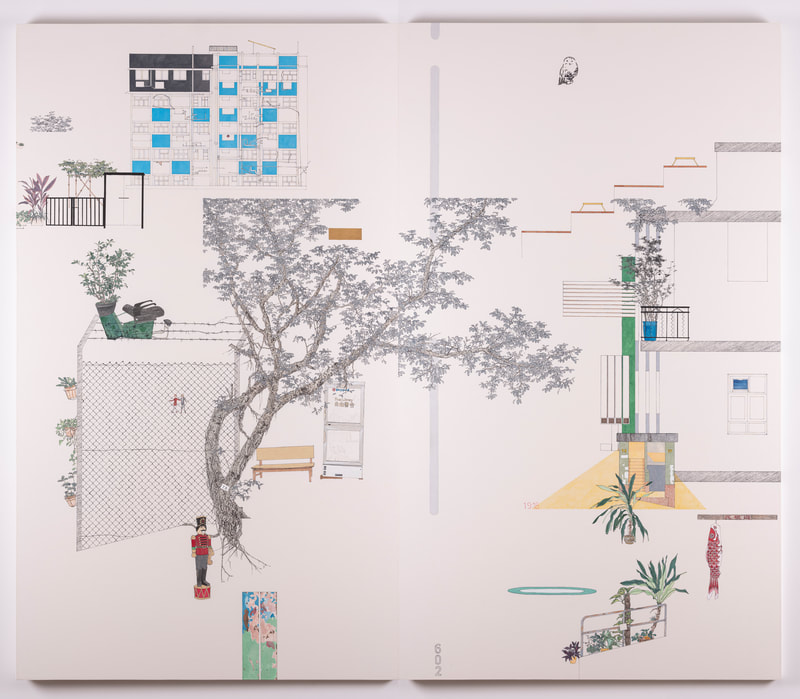Frank TANG Kai Yiu 鄧啟耀 : You are here 《你在此》
|
|
Frank TANG Kai Yiu 鄧啟耀 : You are here 《你在此》
11 June 2022 – 9 July 2022 Gallery EXIT is delighted to present Frank TANG Kai Yiu’s solo exhibition ‘You are here’, showcasing the artist’s works made between 2018 and 2022, in which are portrayed places and landmarks of Hong Kong through various mapping approaches and visual presentations. The works exhibited in this exhibition mainly revolve around the history, landscape and people’s lives of a place, where all kinds of relationships and emotions are woven by means of mapping and placed in the contexts of contemporary society and contemporary art. The exhibition will open on Saturday 11 June, and will run till 9 July, 2022. Maps are worlds seen through the cartographer's eye, spaces represented in a specific way. They may be real or unreal, like the fictional worlds in myths and legends, folklore, hailed from the imagination of the creator. While objective facts are real, the creator’s observations of and feelings for a place are no less so, only becoming fictional when presented as works of art. In contemporary art there is no lack of works that take the ‘map’ as theme, or ‘mapping’ as creative trajectory or strategy. Through maps in different forms, artists all over the world explore and discuss contemporary issues such as racial conflicts, globalisation, ecology, body politics, identity and utopia. Encompassing a rich array of visual elements, maps can also be presented in many different forms. As the visual culture studies scholar Giuliana Bruno points out in her book Atlas of Emotion, there is an intricate relationship between maps and journeys. People navigate and learn about a place following the signs and directions in maps; a familiar place is experienced anew from another perspective proffered by the cartographer’s purposeful selection and narration. More than an engagement of visual and personal associations, it involves all the bodily senses. Through these mapping methods, Tang’s works discuss real and imaginary spaces, active and passive journeys, and the emotional projections elicited by maps. The coordinates sometimes found on maps indicate the map reader’s current location on the map. By matching the landmarks, signs and symbols on the map with the surrounding, the map reader tries to find his or her way. Maps communicate, constructing spaces with abstract symbols. Depending on the cartographer’s data research, visual selection, emotional expression and purpose, the map becomes a bridge through which the cartographer communicates with map readers, allowing the latter to experience the world in the map. In painting, composition is a kind of mapping, and for the artist there are multiple ways of presentation. Known for his contemporary approach to Chinese ink painting, Tang’s works reference the styles of artists from different eras. Zhongshan Park (2022) appropriates the composition and the colour scheme of landscape painting from Northern Song and Qing Dynasties, emphasising the ‘travelability’ of Chinese landscape paintings. Visually the viewer is led into the park, following a path, eventually climbing to the top of Castle Peak looming at the back. Tung Lin Kwok Yuen (2019) references some mythological maps. Vegetations are derived from archetypes in gongbi paintings. Composed of drawings in the style of tourism illustrations, Shing Wong Street (2021) demonstrates the local communal culture and illustrates the history and structure of the street, indexing its colours and other man-made things. Drawn from parks in Wanchai, the Pocket Park series (Tai Wo Street Playground, Queen’s Road East/Swaton Street Sitting-out Area, Dominion Garden, 2018) is filled with index symbols, elucidating the symbiosis of man, man-made nature and nature, encapsulating the parks’ designs and behaviours of people. With painting as the chief medium, the artist attempts at the same time to present his works through sound performances and sound installations, to better demonstrate the absurdity of this symbiosis, a certain harmony not without its hypocrisy. While the Pocket Park series is presented alongside a sound recording installation, Our Audible City series (The Haw Par Mansion, Tung Lin Kwok Yuen, North Kowloon Magistracy, The University of Hong Kong, Tai Kwun, Peng Chau, 2018–2019) utilises sound performance as a mapping method. Related Articles:
|








